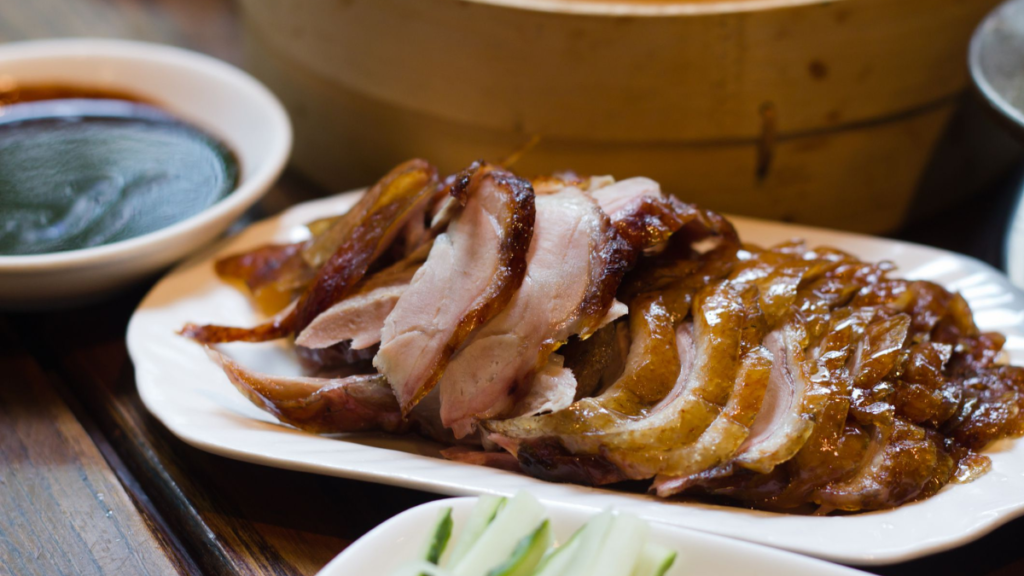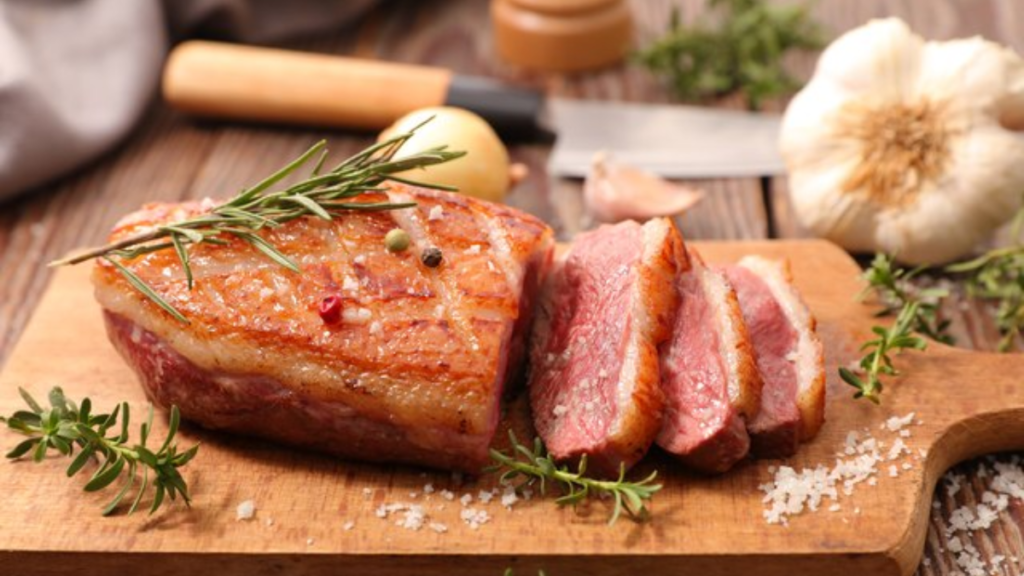Despite its high-fat content, Duck is more nutrient-dense than you might think. Despite being high in healthy unsaturated fat, it has a rich, meaty flavor. If you want to know about the nutritional value per 100g, of duck, In this article, you will get all the crucial information about duck nutrition facts. Most cooking methods involve rendering the majority of the fat from the duck, leaving crispy skin and lean meat. Cooking with rendered duck fat is a healthier alternative to using butter or other animal fats.
Duck meat is incredibly flavorful and nutritious. It’s high in protein and omega-3 fatty acids, and micronutrients like selenium, iron, and niacin. Duck eggs are also high in nutrients, with a nutrient profile similar to chicken eggs (with higher amounts per egg because duck eggs are more significant than chicken eggs.)
Duck Nutrition Facts
Here is a table with Duck Nutrition Facts per 100-gram serving, based on data from the United States Department of Agriculture (USDA):
| Nutrient | Amount per 100g | % Daily Value* |
| Calories | 337 kcal | 16.9% |
| Total Fat | 27.7 g | 42.6% |
| Saturated Fat | 8.4 g | 41.9% |
| Cholesterol | 106 mg | 35.3% |
| Sodium | 74 mg | 3.1% |
| Total Carbohydrate | 0 g | 0% |
| Dietary Fiber | 0 g | 0% |
| Sugars | 0 g | 0% |
| Protein | 21.9 g | 43.8% |
| Vitamin D | 0.8 µg | 4.0% |
| Calcium | 13 mg | 1.3% |
| Iron | 2.3 mg | 12.8% |
| Potassium | 275 mg | 5.9% |
Note *Percent Daily Values are based on a 2,000-calorie diet. Your daily values may be higher or lower depending on your calorie needs. This data is for a roasted duck without skin and may vary based on the cooking method, serving size, and other factors.
Duck
Duck is a type of poultry that is especially popular in China, where the ‘Peking Duck’ originated. China is the world’s largest producer of duck meat, accounting for roughly 65 percent of global output.
France is the second-largest producer after China, with the United States in ninth place.
Even though duck is not one of the most popular meats in the Western world, its popularity has grown in recent years. For example, data shows that production in the United States increased by around 20% between 2010 and 2016. The most famous duck meat dish globally is Peking Duck, a Chinese dish.
However, countries all over the world eat a variety of roasted and steamed duck dishes. Duck meat is generally higher in fat content and darker color than other poultry such as chicken and turkey. A duck is classified as a slice of white meat, even though it can appear red when raw.
What are the Health Benefits of Duck?
Duck is an animal protein that contains healthy nutrients such as red meat (such as iron) but without saturated fat.
Boosts the Immune System
Duck (along with Brazil nuts, fish, and other animal proteins) is high in selenium. This antioxidant can help prevent cell damage and inflammation, beneficial to the immune system.
Supports Thyroid Health
Getting enough selenium in your diet is also essential for thyroid health. A 3-ounce serving of Pekin duck meat contains more than half of the daily recommended selenium intake.
Protects Bones
According to some studies, eating animal protein, such as duck, can improve bone density and strength—as long as calcium intake is adequate.
Reduces Heart Disease Risk
Duck, like oily fish, is high in omega-3 fatty acids, which are suitable for your heart. Eating duck (and other forms of poultry) instead of steak and other high-saturated-fat meats can have some health benefits related to cardiovascular disease risk. Duck also contains about as much iron as red meat, significantly more than chicken.
Substitutes for Butter and Other Animal Fats
Duck fat isn’t always healthier than olive oil or other liquid fats at room temperature. While duck fat has a higher percentage of unsaturated fats than olive oil, it still has more saturated fat. It lacks all of the beneficial polyphenols found in extra virgin olive oil.
On the other hand, Duck fat is lower in saturated fat than butter, pork fat (lard), or beef fat (tallow) and can be used in a variety of applications. Remember that, unlike butter, it has a distinct flavor that resembles that of animal fat.
Drawbacks
While duck is a healthy food that contains various health-promoting compounds, contamination is a possible drawback to be aware of. To begin with, research indicates that this problem does not affect commercially raised ducks but rather wild birds.
However, one study discovered that duck species living in aquatic systems near polluted areas had abnormally high levels of mercury and selenium. According to another study, this “could be a health concern” for human duck consumers.
A separate study warns that ducks frequently live in heavy metal-contaminated aquatic habitats. As a result, mercury contamination levels in duck meat are frequently higher than those found in high-mercury seafood. Anyone who eats wild ducks regularly should learn more about the duck’s habitat.
How to Add Duck to your Diet?
You might mistake a whole duck for chicken, goose, or pheasant if you’re not used to cooking duck. Duck breasts and legs are frequently butchered in the same way as chicken and other poultry, but duck meat is darker than most other birds, making it easy to distinguish from other poultry products.
Duck meat, despite its color, is classified as white meat by the USDA. However, it’s sometimes treated like a steak in the kitchen and cooked to medium or even medium rare. However, as with chicken, the USDA recommends cooking duck to an internal temperature of 165 degrees. Duck can be used for more than just meat.
Duck bones can be used to make bone broth for soups such as pho, and duck fat can be substituted for butter. It offal can be prepared similarly to chicken offal, such as liver pâté or pan-fried kidneys. Duck eggs, high in vitamin B12, can also be eaten. Cooking-wise, you can do anything you’d do with chicken with duck. Duck meat can be used in almost any dish, including pot pies, stir-fries, dumplings, and stews.
Is Duck Meat Healthier than Chicken?
Chicken is one of the most widely consumed meats, but duck meat is not. This article will examine what distinguishes these two types of meat, focusing on nutrition and health effects to determine which is the healthier option.
Classification
Due to their low myoglobin content, chicken and duck meat are classified as poultry and considered white meat. On the other hand, duck meat is significantly darker in color and thus contains significantly more myoglobin and iron than chicken meat.
Duck is frequently considered culinary red meat as a result of this. Chickens are divided into four groups by the USDA based on their age and weight: Cornish game hen, broiler-fryer, roaster, and capon. Broiler or fryer duckling, roaster duckling, and mature or old duckling are the four classes of ducks.
Appearance
The color of duck meat is noticeably darker, and a whole raw duck is also more muscular and elongated. The skin and meat of ducks appear to be fatter.
Taste and Use
Duck meat is said to have a more robust, denser flavor than chicken because of its higher fat content. According to the USDA, all poultry, including duck and chicken, should be cooked to a minimum internal temperature of 165oF (74oC). While duck and chicken can be cooked similarly, duck is more commonly served as red meat. Duck, like red meats, can be served medium rare with a light pink interior.
Varieties
While chicken and duck meat can be served as fresh meat or processed product, processed chicken is far more popular. The chicken is usually divided into three parts based on the cut: the breast, wings, and legs.
The chicken breast is the most commonly used and whitest part of the chicken, and the drumstick and thigh are the darker parts of the legs. The wing meat is located between the leg and the breast meat.
The bird’s species determine duck meat varieties. The White Pekin duck is the most famous in the United States. This breed has a lower fat content and a higher protein content than the others. The Mallard, Muscovy, and Moulard are some of the less common breeds.
What is the Storage and Food Safety?
While many chefs prefer medium-rare duck, the USDA recommends cooking duck to a temperature of 165 degrees F, just like any other poultry.
If you’re rendering duck fat, strain it through cheesecloth to remove any bits of meat that may have escaped. Allow cooling before storing in an airtight container for up to 6 months in the refrigerator or a year in the freezer.
Conclusion
One of the most enjoyable aspects of going out to dinner is trying foods that you would never prepare at home. It’s possible that while perusing the menu, you’ll notice a cut of meat that isn’t typically found in a supermarket. Duck meat comes from mallards or other duck breeds, and it can come from both freshwater and saltwater sources. Duck nutrition facts and health benefits are listed below.
One of the most appealing aspects of duck meat is the abundance of nutrients. Duck is a good source of iron, which is required to produce hemoglobin, a component of red blood cells. Iron is also necessary for children’s energy production. Duck meat contains many proteins that are important for keeping your body running smoothly. These proteins can help repair damaged skin while also keeping your body active.
Proteins are also necessary for maintaining your health by assisting your body’s natural immunity. Vitamin B is the most abundant nutrient in duck meat. Duck meat is high in various vitamin B compounds, particularly B-12. Vitamin B-12, like iron, is essential for red blood cell formation, and it also absorbs folic acid, which helps the body release energy.


